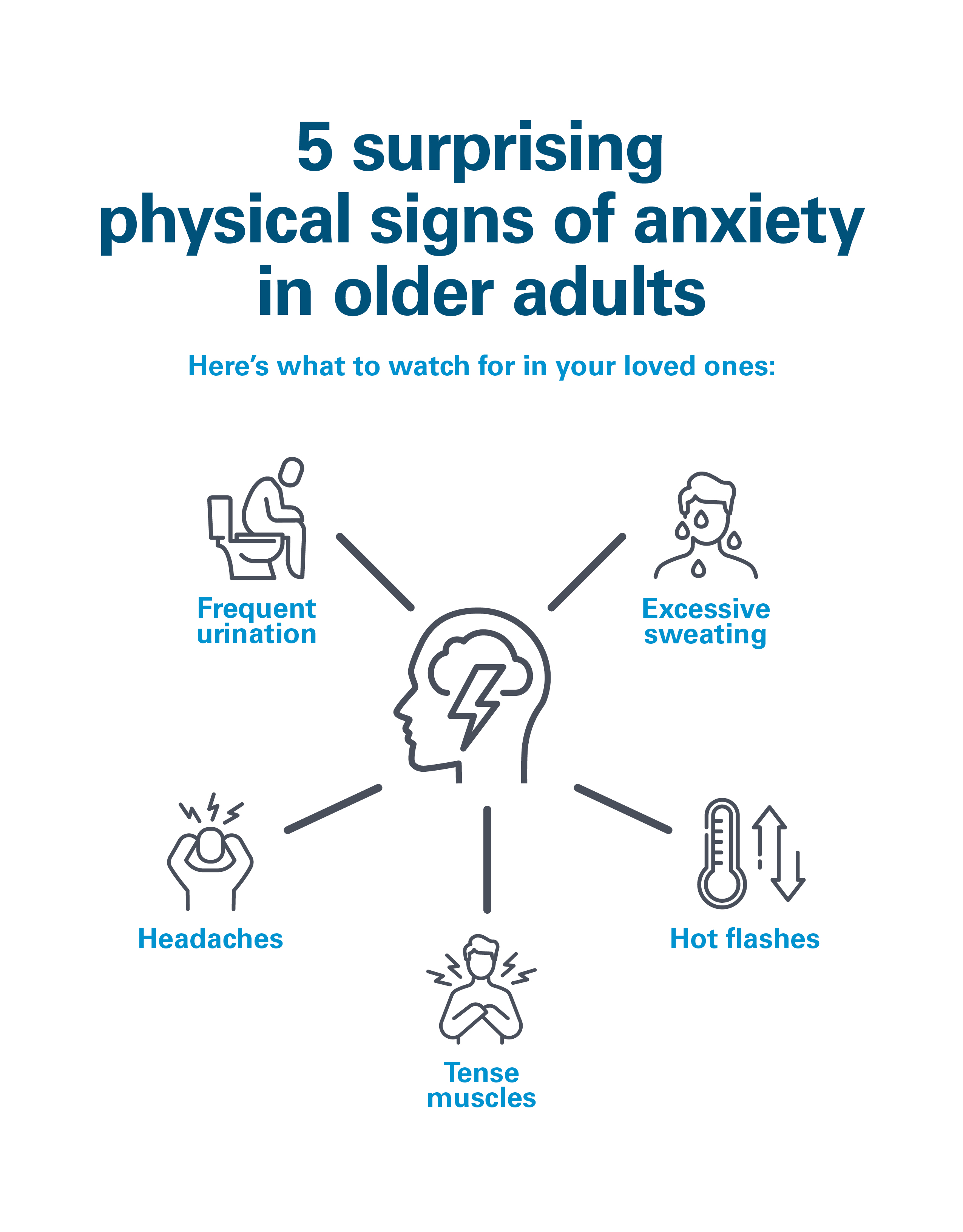What anxiety looks like in older adults — and how to help
Anxiety is one of the most common mental health conditions in people ages 65 and older. Here's what you need to know to help your loved one feel calmer.

It’s normal for older adults to feel stressed sometimes. They may be worrying about health conditions, mobility issues, or living on a fixed income. But when your loved one’s fears start to affect their day-to-day life, they may be dealing with anxiety.
Anxiety is not an unavoidable part of aging, and it’s not the same thing as stress. According to the American Psychological Association, stress is typically caused by some kind of trigger, such as an argument with a friend. Anxiety, on the other hand, is a mental health condition that doesn’t go away on its own, even after the stressor does.
Generalized anxiety disorder is the most common anxiety disorder in older adults, according to the Anxiety and Depression Association of America. Up to 15percent of people ages 65 and older have an anxiety disorder.
According to the National Council on Aging, some of the top causes of anxiety in older adults include:
- Childhood trauma
- Chronic health conditions
- Financial insecurity
- Loss of independence
- Medication side effects
- Misuse of alcohol or prescription medicines
- Mobility issues
- Sleep problems
- Stressful life events (such as the death of a loved one)
You may feel helpless watching your loved one struggle with anxiety. But there are steps you can take to support them. Here’s what you need to know about spotting anxiety in older adults and helping them feel better.
Join IBX for one of our Weekday Wellness events! These free, virtual events are open to the public. Register now to secure your spot. This is an educational event. For accommodations of persons with special needs at meetings, call 1-877-393-6733 (TTY/TDD: 711).
What are the symptoms of anxiety in older adults?
Anxiety in older adults is marked by behavioral symptoms such as:
- Insomnia
- Nightmares
- Obsessive thoughts
- Reactions that are disproportional to the triggering fear
- Refusal to engage in routine activities
- Restlessness
- Trouble with memory and focus
- Uncontrollable feelings of panic, fear, or apprehension
Although anxiety is a mental health condition, it can have physical symptoms too. That’s because anxiety activates the body’s sympathetic nervous system, also called the fight-or-flight response.
Anxiety may also manifest in the body as:
- Cold or sweaty hands
- Dry mouth
- Nausea
- Racing heart, or heart palpitations
- Shortness of breath
- Trembling
How can I help if I notice anxiety symptoms in a loved one?
There are plenty of ways you can help support an older adult who may be dealing with anxiety. Try these strategies to help them find treatment and feel better.
Have a conversation with them.
Your loved one may not know that what they’re experiencing is anxiety. Instead, they may complain about feeling “off” or sleeping poorly. It can help to have a conversation where you bring up your concerns. Consider talking about topics such as:
- Daily routines. Is your loved one avoiding activities they once enjoyed?
- Medication. Are they taking a new medication, or has their dosage changed for a medication they’ve been taking? Have they recently stopped taking any medications?
- Mood. How have they been feeling? Have they been feeling numb or experiencing crying spells?
- Substance use. Has your loved one been drinking more alcohol than usual?
- Worries. Have they been worrying more than usual? Do their worries reflect reality, or are they disproportional to the situation?
Help them schedule a visit with their doctor.
Your loved one’s health care provider can help rule out any underlying medical conditions that might be causing anxiety, such as a thyroid problem. Certain medicines can also make anxiety symptoms worse. The doctor may even recommend that your loved one talk about their symptoms with a therapist or psychiatrist. Talk therapy and anti-anxiety medications are two top treatments for anxiety.
Identify their stressors and help minimize them.
When we feel anxious and overwhelmed, it can feel tougher to find solutions to problems. That’s where you can help. For example, if your loved one is retired and worried about living on a fixed income, you can help connect them with a financial planner.
Encourage them to develop de-stressing techniques.
Stress relief practices can help ease your loved one’s anxiety symptoms. You can suggest practices such as:
- Deep breathing
- Meditation
- Mindfulness
- Yoga
Encourage them to get moving.
Research shows that physical activity can help combat anxiety in a big way. According to the Centers for Disease Control and Prevention, even a single 30-minute walk may help your loved one feel better.
Help them eat well.
To help with stress, the American Psychological Association recommends eating a diet rich in vital nutrients. This means having more fruits, vegetables, nuts, and seeds, and minimizing processed foods.
Encourage a healthy sleep schedule.
Older adults should aim to get between seven and nine hours of sleep every night. But that’s easier said than done. Anxiety during the day can lead to sleep problems at night. What’s more, poor sleep can worsen anxiety symptoms. It’s a vicious cycle, but it’s possible to break it. To help foster a healthy sleep routine, encourage your loved one to wind down before bed. That means no screens, caffeine, or alcohol for at least a few hours before they hit the hay.
It’s hard to watch your loved one struggle with a mental health condition. But it’s important to remember that anxiety is treatable. With your help, your loved one can take steps toward finding the right treatment plan and feeling calmer.



